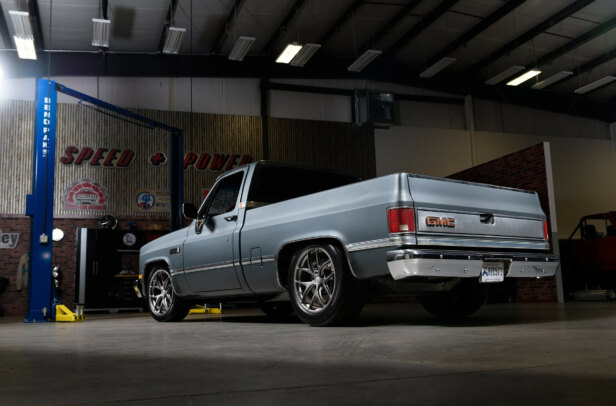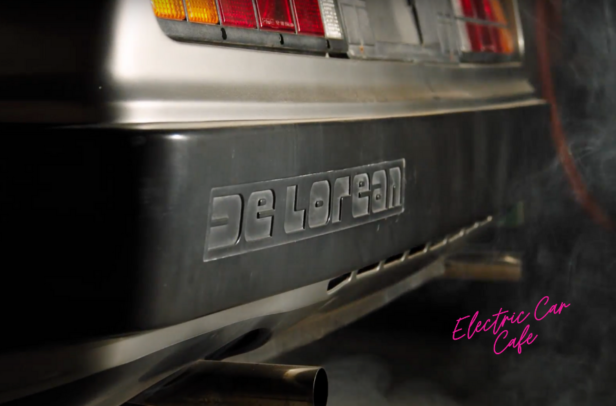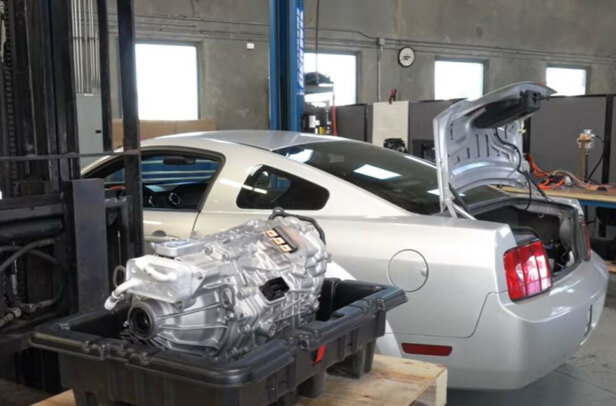Snapshot
- First-time EV owner
- Project began in 2019
- Uses high-power Tesla drive unit sourced from Stealth EV
AMERICAN YouTuber Kevin Erickson has documented himself swapping a Tesla driveline into a 1972 Plymouth Satellite.
Erickson says the Satellite was originally going to take a different path. “I had pulled a 5.7 Hemi that I was going to build and turbo,” he recounts. “Then I got the idea for the Tesla swap.
“I ran it by my wife and she thought it was a great idea. She also asked me how I was going to do it, and although I didn’t know, I told her I’d figure it out!”
He began the project by removing the factory Chrysler 318ci V8, along with the Torqueflite auto, tailshaft and suspension. “With a two-barrel and single exhaust, in 1972 it was rated to 150hp!” he laughs.
Erickson chose to repower the car with a Tesla Ludicrous drive unit sourced from Stealth EV. Pulled from low-mileage Model S and Model X cars, these drive units contain an electric motor, an inverter to transform DC battery power into useable AC, and a diff. With the unit mounted in the rear of a car, the need for a gearbox and tailshaft is eliminated. The Ludicrous name refers to Tesla’s maximum acceleration mode, which boosts responsiveness at the cost of increased battery consumption.
Stealth EV currently offers its Ludicrous kit for US$12,000, containing a Tesla drive unit and much of what is needed to manage it independently of the donor car. This includes a wiring harness and throttle pedal, plus several switches and relays. Stealth EV’s site claims the Ludicrous units are capable of up to 475kW (637hp) in rear-drive applications. Erickson says his Electrollite should make around 600hp, with a maximum range of about 400km. Like all EV motors, peak torque is available from 0rpm.
To contain the drive unit, an entire Tesla rear subframe was bolted into the Satellite, necessitating some cutting of the chassis to keep the undercarriage of the car flush.
The car draws power from a Tesla 100kWh battery that consists of 16 modules, each containing 516 cells. Tesla’s floor-mounted battery pack was unsuitable for the Satellite’s layout, so Erickson used CAD to create a new battery shelf set-up. This bolts into the engine bay via custom mounts, which rest on a Gerst Tubular Suspensions front end. Another battery box resides in the boot, which required Erickson to fabricate a cantilever suspension set-up as a space-saving measure. The battery management system (BMS) board of each module was replaced with a Stealth EV unit, as Erickson says the company offers superior tech support when required. Despite the support, he admits the BMS wiring was daunting. “Finding a method to control the battery coolant pump, heater, three-way valve and radiator fan that would work while driving and also while charging was imperative for battery health,” he says.
Though it receives different inputs than a fuel-burning engine, the Electrollite’s management system still runs a CAN bus and OBD-II port for straightforward code diagnosis. A pair of removable, wirelessly charged tablets were integrated into the original Satellite instrument panel. Cruise control also made the cut, enabled by a dash-mounted rocker switch. Like virtually all EVs, the accessory system is still powered by a standard 12V lead acid battery, itself taking a stepped-down charge from the high-voltage pack.
Sound deadening became an important factor of the car’s build, with no engine noise to mask annoying squeaks and rattles. Erickson laid down a thick coat of sound and heat insulator on the floorpan to mitigate as much extraneous noise as possible.
He also avoided unnecessary drilling by running wiring through existing holes when practical, and replaced the obsolete number-plate fuel filler with a charging socket, which has the added effect of hiding the car’s electric nature when parked.
In keeping with the Electrollite’s modernised driveline, Erickson made a number of restomod-style changes. Notably, the headlights were replaced with LED units originally produced for motorbikes, and 20-inch wheels were chosen to clear the Tesla’s Brembo brakes. He also packed the factory Tesla diff with a limited-slip centre to improve traction during hard launches.
Steering is controlled by an electric rack, which Erickson says offers great feel. “It’s adjustable, so if you want it to feel more firm, for instance at high speed, you can just dial that in at any time.”
The most recent YouTube instalment of the Electrollite build was released on 11 May, though Erickson has since posted more footage of the car being driven on his social media platforms. But there is still some work to be done.
“The major things left on my list are to skin the bottom of the car and finish the interior assembly,” he says. “I’m replacing all of the side glass and adding power door locks, plus final organisation and protection of wiring under the dash. Then it will just be tuning the inverter to get the most power and driveability.”
Erickson says his first EV has exceeded his expectations. “Having this kind of power, along with the general feel of a classic muscle car, is a combination that I didn’t realise would be so perfect,” he enthuses. “To walk out into the garage, unplug the car and silently rip anytime and anyplace without drawing obnoxious attention is way cooler than I thought it would be.”
When asked his five biggest learning experiences from the build, Erickson said:
“Having a budget is nearly impossible for a project like this. That doesn’t mean to overspend, but to adequately spend.
“Do not let perfection bring the project to a halt. It is easy to worry about each detail too much. It is more important to complete some things and move on.
“Sharing a project publicly on social media is a double edged sword. On one hand you have amazing motivation from fans cheering you on. On the other, the haters will try to tear down your project, especially when you push the limits of what is generally accepted in a car build.
“Modern hot rodding is very much alive! The technology and power will allow us to make cars never before imagined.
“The biggest concern was losing the sound and the soul of the car. I feel no loss, there is something menacing about the silence.”




Comments